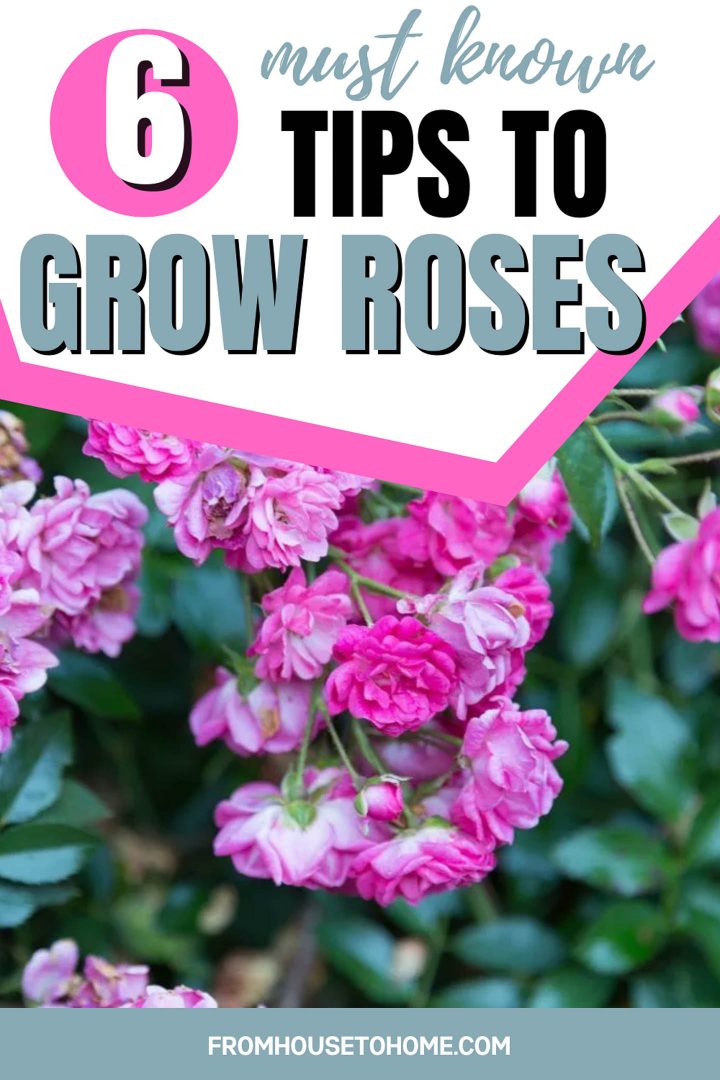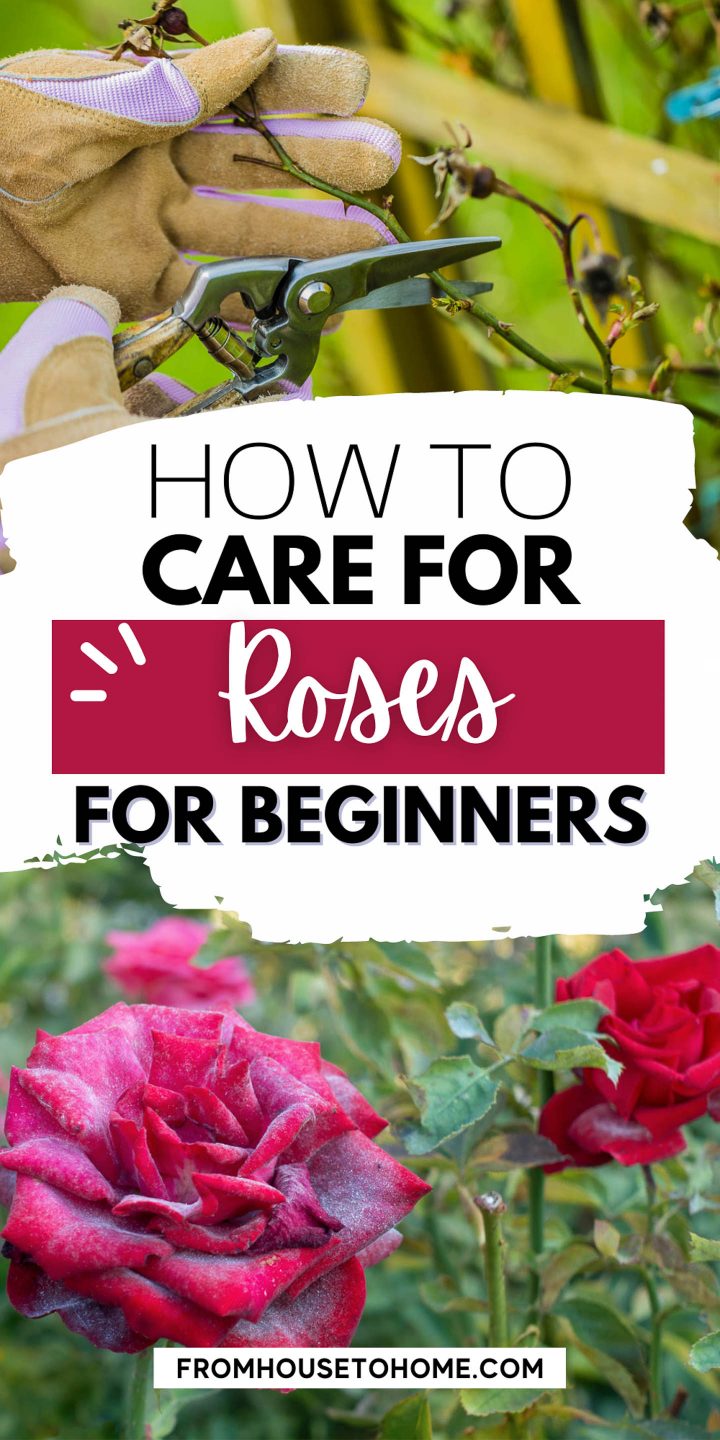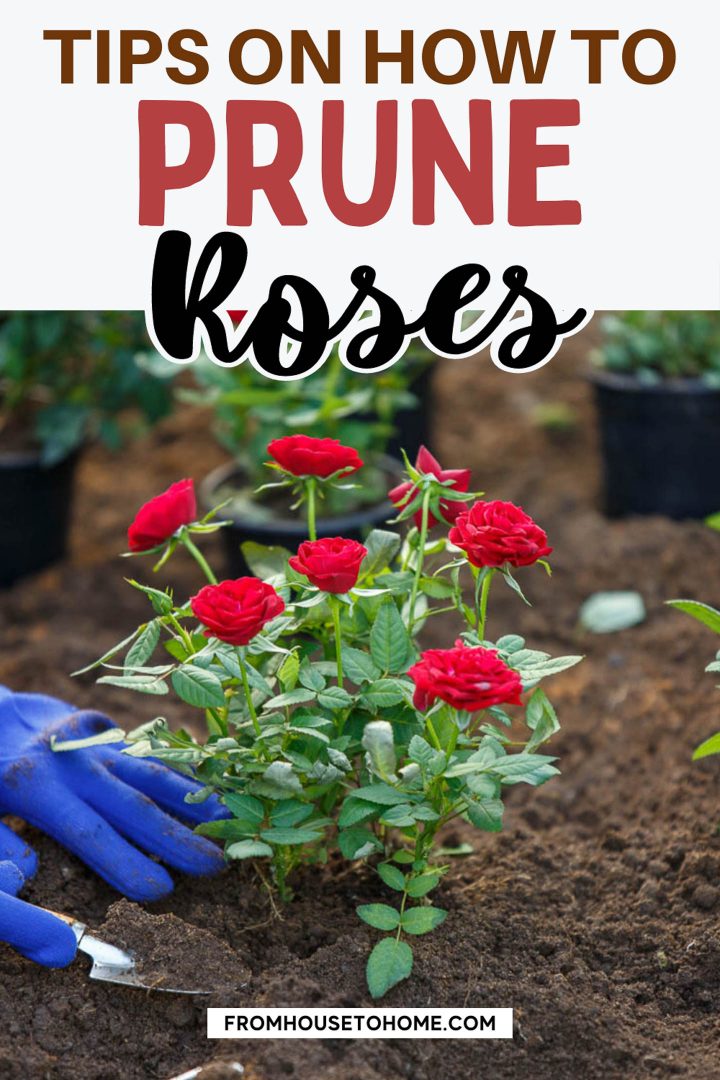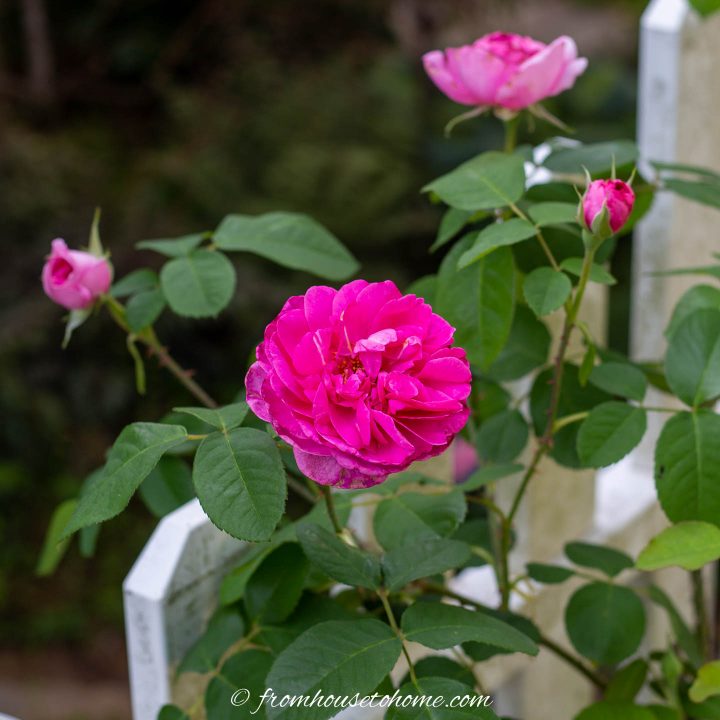How To Grow Roses: Must-Know Tips and Tricks for Stunning Blooms
Roses are a popular plant in many gardens (including mine!). And it's easy to see why. They can be grown in a variety of climates, come in a wide range of shapes, sizes and colors, and (contrary to their reputation) are relatively low maintenance. Since I've had them in my garden for many years now, I'm sharing my tips and tricks on how to grow roses.
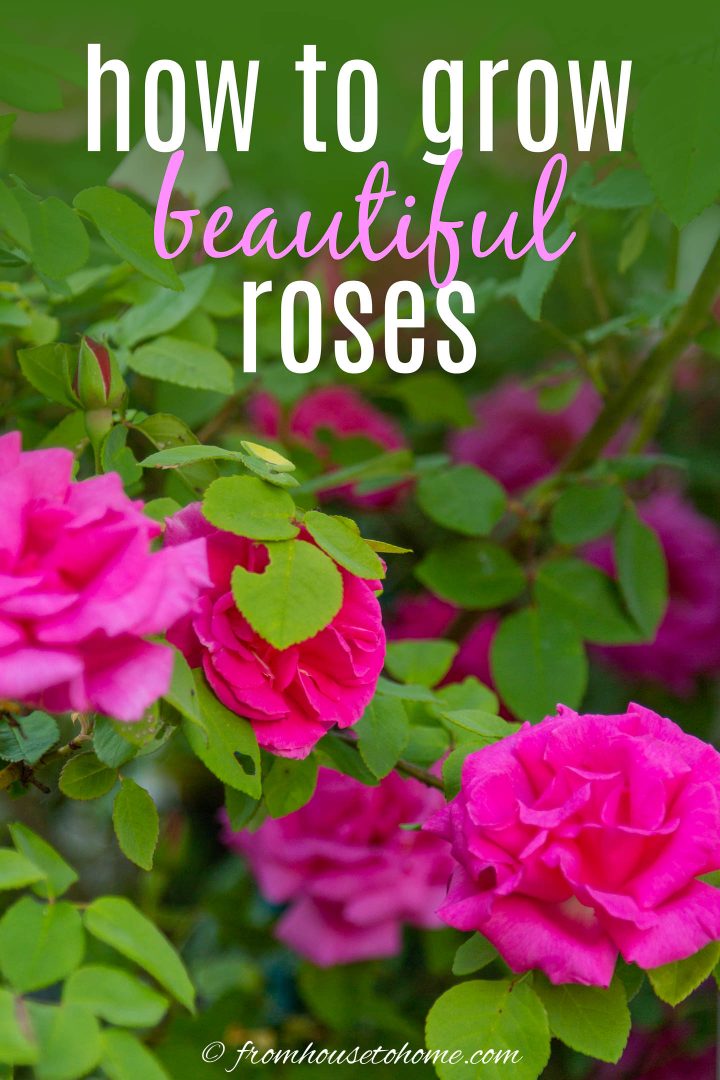
When I think of flowers that look beautiful and smell heavenly, roses are one of the first plants that come to mind.
And when I first started gardening they were one of the first bushes I planted. Because I couldn't imagine having a garden without one.
It is said that over 150 million rose bushes are planted by gardeners worldwide. So clearly, I am not alone in loving them!
While they are beautiful and prized, roses have a reputation of being hard to grow.
Well, I'm here to tell you that they are easier to care for than you think!
If you’re looking to plant them in your garden this year, here is everything you need to know about how to grow roses.
All about rose bushes

Zones: 3 to 10
Light: Full sun to partial shade
Bloom time: Spring through summer
Size: 6 inches to 50 feet (there are a ton of varieties)
Where do they come from?
Roses first became cultivated in Asia approximately 5000 years ago. They existed there for thousands of years before they came to the west.
Zones

Roses are hardy in zones 3 to 10 with different varieties available for different zones.
In the coldest zones, look for the Explorer Series and Rosa rugosa varieties.
Most roses will survive in the hottest zones, but root nematodes can be a problem. Which means the plants start out fine, but start to die off after a few months as the roots are attacked. If so, look for roses that are grafted onto Rosa fortuniana rootstock or grow them in raised beds that are not touching the ground.
The middle zones are prime rose-growing areas.
Ask your local garden center for their recommendations, and be sure to check the tag for more information before purchasing your rose plant.
Flower colors

Most of us are familiar with the rainbow of roses we see in bouquets.
In terms of garden roses, you can find them in pink, orange, yellow, purple, white, and of course, red. (Some breeders claim to have blue roses, too, but all the ones I've seen are actually purple).
Bloom time
Depending on the type of rose you have, you will have different bloom times. Some roses will only bloom once a year, while others bloom consistently throughout the spring and summer.
Usually, the first round of blooms for a rose plant will be the most impressive of the year.
As quick growers, most roses will flower their first year after being planted. However, more mature rose plants will have more abundant blooms than younger ones.
Size

I know it sounds crazy, but rose plants really do range from 6 inches to 50 feet tall! Of course, those are the two extremes.
Miniature roses range from 6 to 48 inches, creating tiny adorable rose bushes.
The climbing varieties will reach heights of 8 to 15 feet tall.
The most popular roses in many gardens are the hybrid tea varieties, which range from 4 to 6 feet in height.
I happen to love many of the old heirloom roses (they are usually the easiest to care for). Most of them also fall into that 4 to 6 feet tall range, although they can get bigger if you don't prune them back.
Types of roses

When buying roses, it’s a good idea to know all the options out there. One of the world’s oldest cultivated plants, there are a ton of varieties to choose from.
The American Rose Society classifies roses into three main categories: species (or “wild”) roses, old garden roses and modern roses. Old garden roses are considered anything bred prior to 1867. The year is significant as that is when the popular hybrid tea rose made its debut.
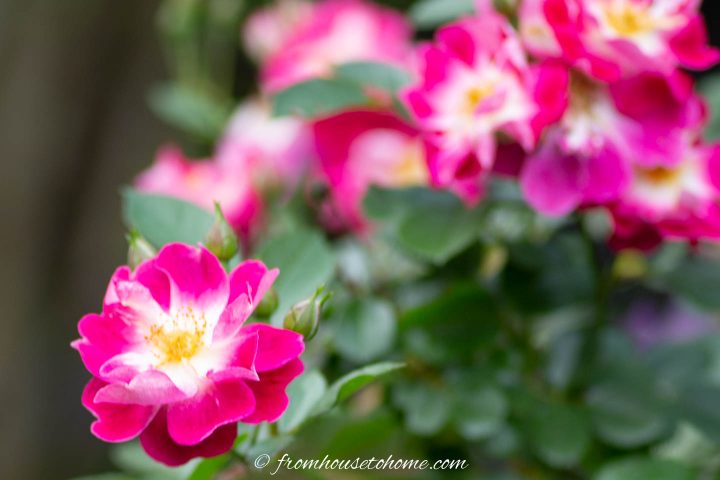
Among the types of roses, you can find:
- Miniature roses for the front of the border
- Climbing roses to cover fences or pergolas
- Heirloom roses for low maintenance
- Shrub roses to create privacy
- Hybrid tea roses to decorate your garden
When choosing your rose, consider your space and how much room you have for your mature rose to grow into.
Many modern hybrid roses have lost the signature rose scent. Instead, they have been bred for their color and bloom size. Find older and heirloom varieties if you’re looking to inhale that signature floral scent.
I also don't plant many Hybrid Tea roses in my garden. I think many of the other rose types have nicer plant shapes, and are easier to grow successfully.
How to plant roses
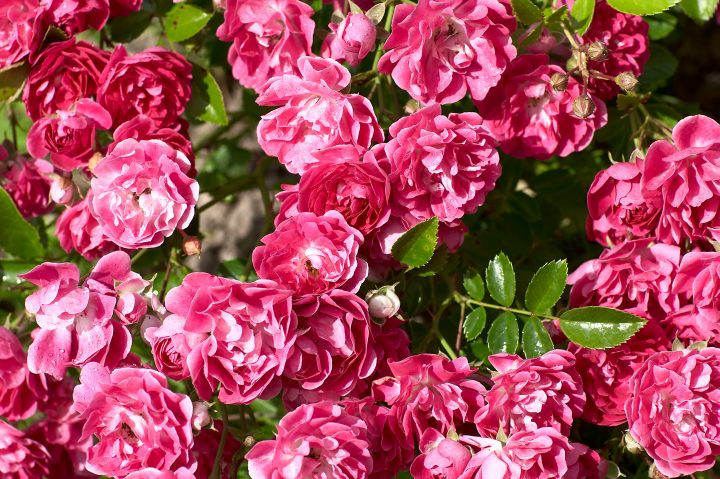
Before you can plant a rose, you need to buy one.
There are two ways to get them:
- In containers, which are easy to grow and good for beginners.
- As bare-root plants, which have a better selection of varieties but can be harder to keep alive and often require more maintenance upon planting.
When to plant
The best month to plant roses depends on where you live. Ideally, you want to put them in the ground in the fall, six weeks before the first frost. If you live in North America, you can find your first frost date from the Farmer's Almanac and work backward from there.
Planting your roses before the first frost allows them to establish roots before they go dormant for the winter. Come spring, they will be ready to bloom!
However, you can also plant them in the spring after the last frost.
Most bare-root roses are only available in the spring and should be planted as soon as you get them. I like to put them in potting soil in a container for the first summer and then plant them in the ground in the fall. They seem to have a better survival rate that way.
Roses coming in containers are fairly flexible. While fall is the ideal time to get planting, feel free to plop them in the ground if you purchase one during the summer. Make sure it is well-watered and cared for, especially if it’s hot.
Where to plant

Choosing the perfect home to grow your roses could mean the difference between big blooms and sparse little ones.
Roses grow best in full sun, ideally receiving at least 6 hours a day.
As with many plants, where you live has an impact on how much sun they need. In hot climates, they can take a little more shade. In colder climates, gardeners may want to plant their rose by a south-facing fence or wall to maximize sunshine and help minimize winter damage.
Roses don’t like to have soggy roots so put them in a location that drains well.
In fact, they do much better in conditions that are too dry than too wet.

This ‘Zepherine Drouhin' climbing rose is growing right beside my house under the roof overhang. And I have no watering system that reaches it. So the soil is pretty dry most of the time.
And as you can see, the rose is quite happy there. (As a side note: ‘Zepherine Drouhin' has no thorns so it's the perfect rose to go over a walkway).
Soil
Roses like well-drained soil with lots of organic matter.
Before planting, be sure to add in some compost and work it into the soil.
How to plant

Once you have a sunny spot with good drainage, prep your soil.
- Dig a planting hole that measures the same size as your rose’s root ball.
- Mix some compost in with the soil to provide the roots with extra nutrients for growth.
- Plant your rose, ensuring that the crown is at ground level for mild and warm climates. Or if you live in a cold climate, plant it 2-3 inches deeper.
- Pack in your soil and water your plant thoroughly.
- Add a slow-release fertilizer, then water again.
- If you are planting more than one bush, space them 3 feet apart from one another.
And that’s it! Keep an eye on your newly planted rose and ensure it stays moist until the roots have developed.
How to care for roses
Watering

Like many established shrubs and perennials, roses don’t have high water demands.
Keep the soil moist throughout the growing season but never soggy.
Sandy soils require more watering than clay soils. Adding some peat moss may be beneficial to help with water retention.
Hot and windy conditions will also require more water.
While watering, avoid getting the leaves wet. Instead, aim the water at the crown of the plant with a soaker. This will help to prevent diseases like mildew and black spot from spreading.
Putting down mulch and planting ground cover around the plant will also help the soil to retain moisture.
Pruning

If you’re new to pruning, roses are a great plant for you. It is extremely difficult to kill a rose bush by over-pruning.
In fact, I often cut my roses almost all the way down to the ground and they always come back better than ever.
Rose stems should be pruned in early spring when they are just beginning to grow.
Start by cutting off any dead or damaged stems (the branches will look dark brown or black).
Then cut back each of the living stems by about a third (or more if your rose has grown larger than you want).

When you're cutting off the branches, first find a bud eye (where new growth is starting) or mature set of leaves. Then make the cut a little above it on a 45-degree angle away from the growth.
If you have a rose bush that reblooms, you may need to deadhead the flowers. This means clipping off any dead flower blooms to encourage the bush to create more. Some reblooming varieties don’t produce rose hips (that's what the seed pods are called). In that case, no deadheading is needed.
You'll also need to look for (and prune) suckers if you have bushes that have been grafted onto a different root stock (you'll see a big knot close to the bottom of the stem if it has). These are shoots that are growing from the root stock and will not have the same flowers as the plant you are trying to grow. Cut them right off at the base as they can take over your whole rose bush if you let them grow.
It also helps to invest in a good pair for long-sleeved rose gloves (like these ones* from Amazon). These will save your hands and arms from getting too scratched up.

Unless you have planted my favorite ‘Zepherine Drouhin' which doesn't have any thorns.
Fertilizing
For gorgeous and frequent blooms, fertilizer will be your rose's best friend.
At the beginning of each season, I like to put down a layer of compost that acts like a slow-release fertilizer. (You can also use a store-bought fertilizer).
Then wait until the plant produces its first blooms before putting down the next round, which can be natural (such as fish emulsion) or a chemical one that is high in nitrogen. If you are using the latter, always water before and after the application to prevent the roots from getting burned.
Fertilize again about a month later. If you have a long growing season, you may need another application later in the season. But stop fertilizing 4 to 6 weeks before fall starts to prevent new growth that can be damaged if it gets cold too quickly.
Avoid fertilizing when it’s super hot, as this can stress out the plant.

How to grow roses from cuttings
If you want more roses, you can actually propagate them from cuttings.
While propagating a perennial may sound tricky, it’s not difficult at all.
Cuttings are best taken in the early growing season.
The flexible green softwood will root the easiest.
Before you make your cutting, examine your rose plant.
Only take cuttings from healthy, disease-free sections of the plant.
- Find a stem that has a spent bloom on the end. Cut above the hardwood (woody, mature wood of the plant) and the spent bloom. Use a sharp, sterile knife to make your cutting. The best time of day to cut is in the morning while the plant is well hydrated.
- Remove the tip of the cutting.
- To plant your cutting, you want the stem to be 6-8 inches in length. The stem should have 4 nodes (where the leaves emerge from the stem).
- Remove 3 of the 4 leaves from the nodes, leaving only the top leaf.
- Dip your rose cutting in rooting hormone and then place two inches deep into the soil, or until 2 nodes are below soil level.
- Cover your cutting with a clear plastic bag to create a mini-greenhouse and place it in bright, indirect light.
- Keep your cutting moist but not soggy. After 10-14 days, it should take root!
Remember, not all cuttings will take. Some varieties are more difficult to root than others. Be patient, and don’t get down on yourself if you lose a few cuttings.
Common pests and diseases
Pest control

As far as pests go, aphids, Japanese beetles, sawflies, and spider mites all enjoy roses.
While none of them will kill the bushes, they can destroy the flowers. Which kind of defeats the purpose of growing roses.
To prevent or get rid of the bugs, you can treat your roses with one of these natural home remedies or buy chemical pesticides.
Disease prevention
When growing roses, your best bet for avoiding diseases is to choose disease-resistant varieties.
Ask your local garden center for suggestions, and always read the tag carefully before purchasing.
Powdery mildew

Powdery mildew affects many roses. In the summer months, look for a white and powdery film on the flowers and leaves, causing the leaves to curl. While it doesn't kill the plants, it certainly doesn't look very attractive!
To avoid this disease, make sure your plant has enough circulation among the branches. Avoid growing roses too close to one another and prune any stems that cross or get too crowded.
Try to avoid getting the leaves wet when you water, and water in the morning so any splashes will dry up more quickly.
Planting your rose in an area with enough sun will also help prevent the disease.
If your roses already have powdery mildew, make sure to clean your pruners between cuts to prevent it from spreading to other plants. Also prune off any diseased stems and pick up any diseased leaves that have fallen. Then throw them in the trash (not the compost)
Black spot
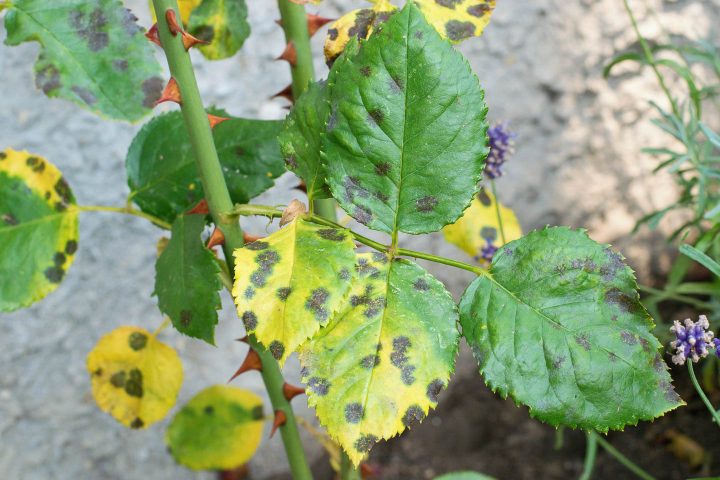
Black spot is another waterborne fungal disease that can affect the look of your rose, but doesn't usually kill the plant.
It looks like circular black or brown spots across the leaves.
You can avoid black spot the same way you would powdery mildew, with proper air circulation, watering the roots (not the leaves) and planting in lots of sun.
In the humidity of our summers, almost all of my roses get black spot at some point during the summer. And honestly, I just ignore it. However, you can buy a fungicide spray that will help to prevent it if you want to prevent it.
As with powdery mildew, make sure to clean your pruners between cuts and throw away any diseased stems or leaves (rather than composting) to prevent black spot from spreading to other plants.
By following the tips in this guide on how to grow roses, you’ll have some of the most beautiful blooms in the neighborhood.
Other sun-loving plants you might like
Or read our landscaping ideas for roses.
Have comments or questions on how to grow roses? Tell us in the section below.
Pin It So You Don't Forget It!

This post was originally published on June 3, 2021 but was updated with new content on November 23, 2024.

